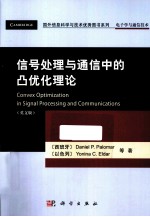
- 作 者:(西)帕洛马等著
- 出 版 社:北京:科学出版社
- 出版年份:2013
- ISBN:9787030354303
- 标注页数:498 页
- PDF页数:512 页
请阅读订购服务说明与试读!
订购服务说明
1、本站所有的书默认都是PDF格式,该格式图书只能阅读和打印,不能再次编辑。
2、除分上下册或者多册的情况下,一般PDF页数一定要大于标注页数才建议下单购买。【本资源512 ≥498页】
图书下载及付费说明
1、所有的电子图书为PDF格式,支持电脑、手机、平板等各类电子设备阅读;可以任意拷贝文件到不同的阅读设备里进行阅读。
2、电子图书在提交订单后一般半小时内处理完成,最晚48小时内处理完成。(非工作日购买会延迟)
3、所有的电子图书都是原书直接扫描方式制作而成。
1 Automatic code generation for real-time convex optimization&Jacob Mattingley and Stephen Boyd 1
1.1 Introduction 1
1.2 Solvers and specification languages 6
1.3 Examples 12
1.4 Algorithm considerations 22
1.5 Code generation 26
1.6 CVXMOD:a preliminary implementation 28
1.7 Numerical examples 29
1.8 Summary,conclusions,and implications 33
Acknowledgments 35
References 35
2 Gradient-based algorithms with applications to signal-recovery problems&Amir Beck and Marc Teboulle 42
2.1 Introduction 42
2.2 The general optimization model 43
2.3 Building gradient-based schemes 46
2.4 Convergence results for the proximal-gradient method 53
2.5 A fast proximal-gradient method 62
2.6 Algorithms for l1-based regularization problems 67
2.7 TV-based restoration problems 71
2.8 The source-localization problem 77
2.9 Bibliographic notes 83
References 85
3 Graphical models of autoregressive processes&Jitkomut Songsiri,Joachim Dahl,and Lieven Vandenberghe 89
3.1 Introduction 89
3.2 Autoregressive processes 92
3.3 Autoregressive graphical models 98
3.4 Numerical examples 104
3.5 Conclusion 113
Acknowledgments 114
References 114
4 SDP relaxation of homogeneous quadratic optimization:approximation bounds and applications&Zhi-Quan Luo and Tsung-Hui Chang 117
4.1 Introduction 117
4.2 Nonconvex QCQPs and SDP relaxation 118
4.3 SDP relaxation for separable homogeneous QCQPs 123
4.4 SDP relaxation for maximization homogeneous QCQPs 137
4.5 SDP relaxation for fractional QCQPs 143
4.6 More applications of SDP relaxation 156
4.7 Summary and discussion 161
Acknowledgments 162
References 162
5 Probabilistic analysis of semidefinite relaxation detectors for multiple-input,multiple-output systems&Anthony Man-Cho So and Yinyu Ye 166
5.1 Introduction 166
5.2 Problem formulation 169
5.3 Analysis of the SDR detector for the MPSK constellations 172
5.4 Extension to the QAM constellations 179
5.5 Concluding remarks 182
Acknowledgments 182
References 189
6 Semidefinite programming,matrix decomposition,and radar code design&Yongwei Huang,Antonio De Maio,and Shuzhong Zhang 192
6.1 Introduction and notation 192
6.2 Matrix rank-1 decomposition 194
6.3 Semidefinite programming 200
6.4 Quadratically constrained quadratic programming and its SDP relaxation 201
6.5 Polynomially solvable QCQP problems 203
6.6 The radar code-design problem 208
6.7 Performance measures for code design 211
6.8 Optimal code design 214
6.9 Performance analysis 218
6.10 Conclusions 223
References 226
7 Convex analysis for non-negative blind source separation with application in imaging&Wing-Kin Ma,Tsung-Han Chart,Chong-Yung Chi,and Yue Wang 229
7.1 Introduction 229
7.2 Problem statement 231
7.3 Review of some concepts in convex analysis 236
7.4 Non-negative,blind source-separation criterion via CAMNS 238
7.5 Systematic linear-programming method for CAMNS 245
7.6 Alternating volume-maximization heuristics for CAMNS 248
7.7 Numerical results 252
7.8 Summary and discussion 257
Acknowledgments 263
References 263
8 Optimization techniques in modern sampling theory&Tomer Michaeli and Yonina C.Eldar 266
8.1 Introduction 266
8.2 Notation and mathematical preliminaries 268
8.3 Sampling and reconstruction setup 270
8.4 Optimization methods 278
8.5 Subspace priors 280
8.6 Smoothness priors 290
8.7 Comparison of the various scenarios 300
8.8 Sampling with noise 302
8.9 Conclusions 310
Acknowledgments 311
References 311
9 Robust broadband adaptive beamforming using convex optimization&Michael Rübsamen,Amr EI-Keyi,Alex B.Gershman,and Thia Kirubarajan 315
9.1 Introduction 315
9.2 Background 317
9.3 Robust broadband beamformers 321
9.4 Simulations 330
9.5 Conclusions 337
Acknowledgments 337
References 337
10 Cooperative distributed multi-agent optimization&Angelia Nedi? and Asuman Ozdaglar 340
10.1 Introduction and motivation 340
10.2 Distributed-optimization methods using dual decomposition 343
10.3 Distributed-optimization methods using consensus algorithms 358
10.4 Extensions 372
10.5 Future work 378
10.6 Conclusions 380
10.7 Problems 381
References 384
11 Competitive optimization of cognitive radio MIMO systems via game theory&Gesualso Scutari,Daniel P.Palornar,and Sergio Barbarossa 387
11.1 Introduction and motivation 387
11.2 Strategic non-cooperative games:basic solution concepts and algorithms 393
11.3 Opportunistic communications over unlicensed bands 400
11.4 Opportunistic communications under individual-interference constraints 415
11.5 Opportunistic communications under global-interference constraints 431
11.6 Conclusions 438
Acknowledgments 439
References 439
12 Nash equilibria:the variational approach&Francisco Facchinei and Jong-Shi Pang 443
12.1 Introduction 443
12.2 The Nash-equilibrium problem 444
12.3 Existence theory 455
12.4 Uniqueness theory 466
12.5 Sensitivity analysis 472
12.6 Iterative algorithms 478
12.7 Acommunication game 483
Acknowledgments 490
References 491
Afterword 494
Index 495
